Dikij Tunec Torrent
See CMOS PLD Programming Hardware and Software Support for information on software / programming, mA ATF16V8BQ 35 mA 40 mA ATF16V8BQL 5 mA 20 mA Highperformance EE PLD CMOS, Description The ATF16V8B is a high-performance CMOS (electricallyerasable) programmable logic device ( PLD, the PLD programmer, and the ATF16V8B can be configured to.  Programming/erasing is performed using standard PLD programmers. See “CMOS PLD Programming Hardware and Software Support” for information on software/programming. BIOS—Basic Input Output System. BJT—Bipolar Junction Transistorbit—binary digit. Blob—Binary large object. Blog—Web Log. BMP—Basic Multilingual Plane. BNC—Bayonet Neill- Concelman. BOINC—Berkeley Open Infrastructure for Network Computing. BOM—Byte Order Mark. BOOTP—Bootstrap Protocol. BPDU—Bridge Protocol Data Unit. Programming/erasing is performed using standard PLD programmers. See CMOS PLD Programming Hardware and Software Support for information on software/programming. CMOS+PLD+Programming+Hardware+and+Software+Support datasheet, cross reference, circuit and application notes in pdf format.
Programming/erasing is performed using standard PLD programmers. See “CMOS PLD Programming Hardware and Software Support” for information on software/programming. BIOS—Basic Input Output System. BJT—Bipolar Junction Transistorbit—binary digit. Blob—Binary large object. Blog—Web Log. BMP—Basic Multilingual Plane. BNC—Bayonet Neill- Concelman. BOINC—Berkeley Open Infrastructure for Network Computing. BOM—Byte Order Mark. BOOTP—Bootstrap Protocol. BPDU—Bridge Protocol Data Unit. Programming/erasing is performed using standard PLD programmers. See CMOS PLD Programming Hardware and Software Support for information on software/programming. CMOS+PLD+Programming+Hardware+and+Software+Support datasheet, cross reference, circuit and application notes in pdf format.
And * • Parkinson's Institute and Clinical Center, Sunnyvale, CA, United States Alpha-synuclein ( non A4 component of amyloid precursor, SNCA, NM_000345.3) plays a central role in the pathogenesis of Parkinson's disease (PD) and related Lewy body disorders such as Parkinson's disease dementia, Lewy body dementia, and multiple system atrophy. Since its discovery as a disease-causing gene in 1997, alpha-synuclein has been a central point of scientific interest both at the protein and gene level. Mutations, including copy number variants, missense mutations, short structural variants, and single nucleotide polymorphisms, can be causative for PD and affect conformational changes of the protein, can contribute to changes in expression of alpha-synuclein and its isoforms, and can influence regulation of temporal as well as spatial levels of alpha-synuclein in different tissues and cell types. A lot of progress has been made to understand both the physiological transcriptional and epigenetic regulation of the alpha-synuclein gene and whether changes in transcriptional regulation could lead to disease and neurodegeneration in PD and related alpha-synucleinopathies. Although the histopathological changes in these neurodegenerative disorders are similar, the temporal and spatial presentation and progression distinguishes them which could be in part due to changes or disruption of transcriptional regulation of alpha-synuclein.

In this review, we describe different genetic alterations that contribute to PD and neurodegenerative conditions and review aspects of transcriptional regulation of the alpha-synuclein gene in the context of the development of PD. New technologies, advanced gene engineering and stem cell modeling, are on the horizon to shed further light on a better understanding of gene regulatory processes and exploit them for therapeutic developments. Introduction Alpha-synuclein ( non A4 component of amyloid precursor, SNCA, chr4q21-22, NM_000345.3, MIM #163890) was the first gene in which a causative mutation for Parkinson's disease (PD) was discovered in 1997 (; ). The detection of alpha-synuclein protein as a constituent of Lewy bodies further strengthened the role of alpha-synuclein in PD and dementia with Lewy bodies (DLB) as a central player in the pathogenesis of neurodegeneration (; ). It is now well-established that rare point mutations and large genomic multiplications of the SNCA gene can cause autosomal-dominant parkinsonism which can present itself as a wide range of clinical and histopathological features including typical PD (), Parkinson's disease dementia (PDD), DLB (), multiple system atrophy (MSA) (), or even fronto-temporal dementia (FTD) (;;;;;;;;; ). Genetic variants in the non-coding region of the SNCA gene, including single nucleotide polymorphisms (SNPs) were discovered by association and genome wide association studies (GWAS) (; ) and small structural variants increase the risk for developing PD (), however the underlying mechanisms are still under investigation as will be reviewed herein.